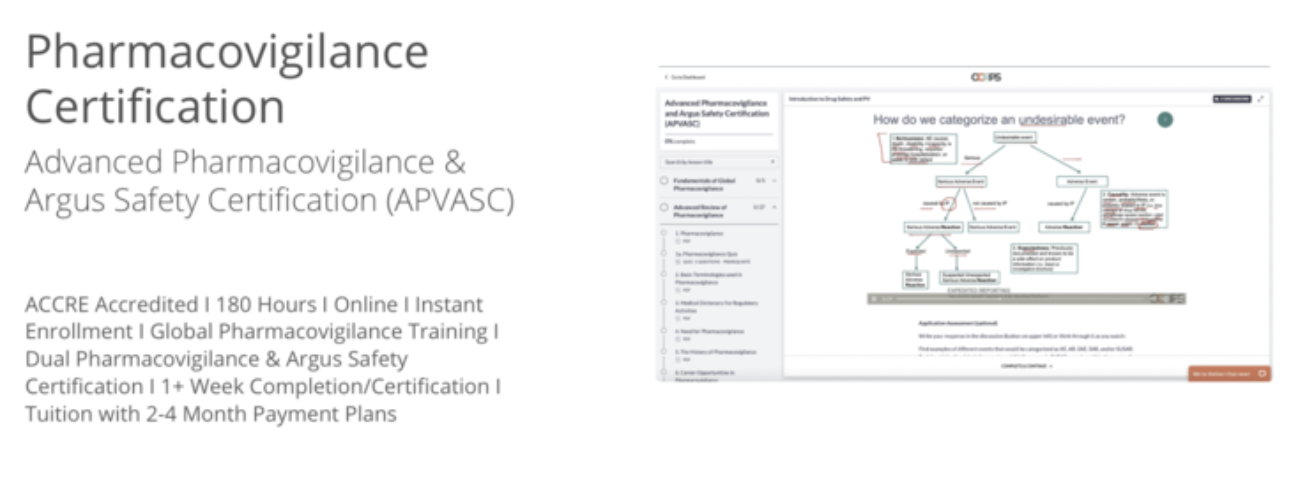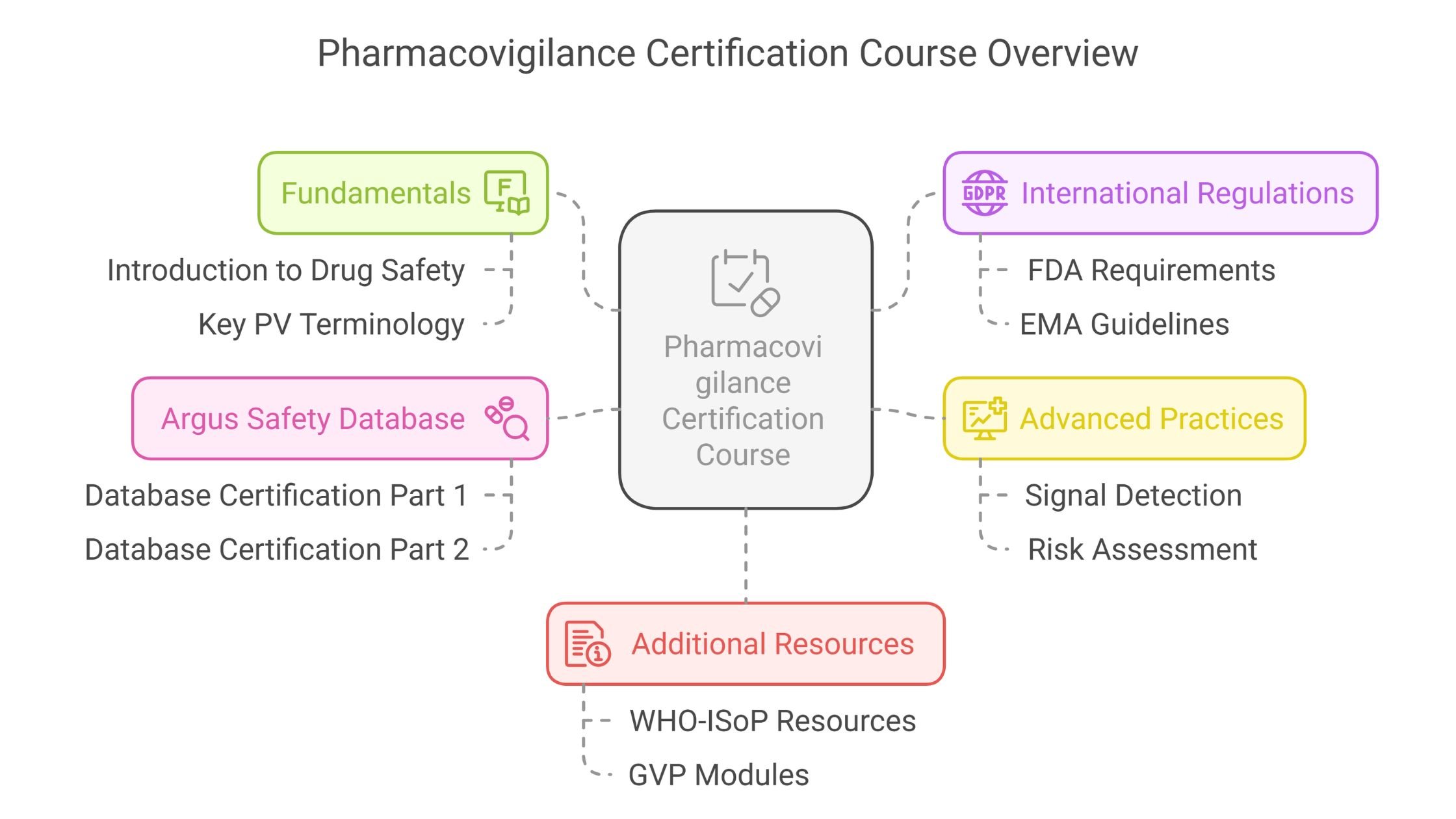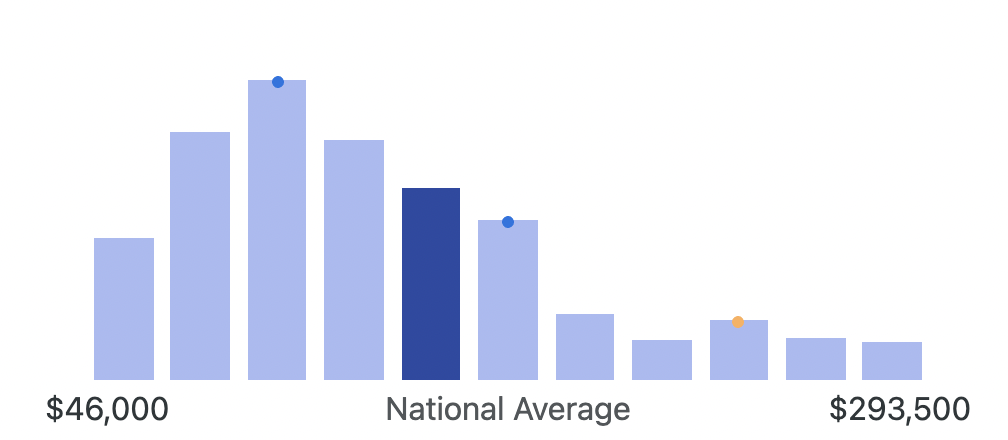Pharmacovigilance: A Complete Guide to Pharmacovigilance and Drug Safety Training
What Is Pharmacovigilance? - Definition, Jobs, Salary, And Pharmacovigilance Certification
Pharmacovigilance
A Guide All About Pharmacovigilance

To increase your chances of getting hired or promoted, scroll below or enroll in our CCRPS Advanced Pharmacovigilance and Argus Safety Certification (APVASC)TM Course which covers drug safety and pharmacovigilance training

What is pharmacovigilance?
Pharmacovigilance Is The Study Of Two Primary Outcomes In The Pharmaceutical Industry:
Safety And Efficacy.
Essentially, it asks does a drug work and is it safe?
Pharmacovigilance is the process of monitoring the effects of drugs, both new and existing ones. This includes collecting data, analyzing it, and taking steps to prevent any negative effects. Pharmacovigilance must happen throughout the entire life cycle of a drug, from when it is first being developed to long after it has been released on the market.
What is the Aim Of Pharmacovigilance?
Pharmacovigilance is required through the entire life cycle of a drug – starting at the preclinical development stage and going right through to continued monitoring of drugs once they hit the market.
Pharmacovigilance includes collecting, analyzing, monitoring, and preventing adverse effects in new drugs and therapies.
It can be broken down into three main sub-specialisms:
Surveillance: Surveillance is geared towards risk management and signal detection. Roles in this specialism focus analysis of drug safety information gathered from other professionals. Surveillance is responsible for creating development safety update reports (DSURs) for drugs in clinical research and periodic benefit-risk evaluation reports (PBRER) for drugs that are on the market.
Operations: Operations focus on collecting and recording information during preclinical development, early clinical trials, and gathering real-world evidence (RWE) of adverse events reported by medical professionals and patients. Operations may also create standard operating procedures (SOPs), individual case study reports, and regulatory reports.
Systems: Systems is concerned with the development of robust systems to store and manage data relating to pharmacovigilance. It involves keeping abreast of changing regulations and guidance in the pharmacovigilance industry and ensuring compliance at all levels of an organization.
The Qualified Person for Pharmacovigilance (QPPV) is responsible for ensuring that an organization's pharmacovigilance system meets all applicable requirements.
What is Pharmacovigilance Training?
If you’re looking to boost your career prospects in the pharmaceutical industry, drug safety training is a great string to add to your bow. Whether you want to move into clinical research or enhance your profile in your existing company, certification is crucial.
If you run a company and want to provide your staff with drug safety training to increase their knowledge and provide a safer working environment, our course is for you too.
We even help train Senior PVs from Fortune 500 companies to improve their efficiency and compliance.
No experience? No worries!
Our triple-accredited Advanced Pharmacovigilance and Argus Safety Certification (APVASC)TM is designed to teach you all you need to know in just 1 week!
Recognized Drug Safety Training I 180 Hours I On-Demand I Accredited I 25+ Modules I Training Compliance I Instant Enrolment I 1+Wk Certification I
What do Pharmacovigilance Officers do?
The exact nature of each role varies, but in essence, Pharmacovigilance Officers (PVs) collect adverse event data on drugs (Phase 4) to analyse and create usage warnings for the drug.
Some roles insist on physicians, nurses, or those with a Master of Science degree. A Master’s in pharmacovigilance is your best route into the industry – but that takes up to 2 years and is very expensive.
Your quicker route into the industry is with a drug safety accreditation.
Please note: A minimum of an associate degree is required to take any training course, including ours.
How To Get Into Pharmacovigilance
The CCRPS pharmacovigilance certification to provide advanced training for entry level pharmacovigilance to ensure you are fully prepared for a career in drug safety monitoring. We are a non-profit organization dedicated to providing advanced pharmacovigilance training to students at all stages of their careers.
The courses provide you with theory and practical-based learning in pharmacovigilance and give you vital industry experience.
Our pharmacovigilance training courses meet
WHO-ISoP and FDA guidelines and are accredited by the ACCRE and other recognized accreditation boards.
You’ll learn the basics of pharmacovigilance, why it’s necessary, its history, and how to find career opportunities within the industry.
You’ll look at different methodologies, pharmacovigilance regulation, pharmacovigilance audit and risk management, and vaccine pharmacovigilance.
You’ll also discover where to find further information to enhance your pharmacovigilance knowledge and study individual case reports to get to grips with the finer details of the subject.
At the end of the course, you will receive your certification. Then you’re ready to set out on your pharmacovigilance career.
After achieving your certification, you’ll open up a world of opportunities in pharmacovigilance and be qualified for entry-level roles including, but not limited to the following Drug Safety Jobs:
Pharmacovigilance Jobs
Pharmacovigilance Jobs Entry Level
18,000 Pharmacovigilance Jobs (always include a SPECIFIC cover letter for all jobs and follow up at least twice by email if you do not hear back to show interest to every single job).
Drug safety or Pharmacovigilance scientist (specialist or associate)
Drug safety or PV manager
Safety or PV reviewer
Pharmacovigilance Quality Compliance
Clinical Quality specialist
Medical Safety scientist/specialist/reviewer
Local safety officer
Clinical trial project safety associate (reviewer or specialist)
MedDRA coder
Pharmacovigilance safety and analytics reporting analyst/specialist/associate
Pharmacovigilance Auditor or PV Inspection readiness officer
• Safety or Pharmacovigilance Physician (medical director, MD/MBBS, IMG)
• Safety Compliance Writer
• Good PV Practices manager
• GCP specialist
• Pharmacovigilance vendor
• Case processing specialist
• Clinical trial case processing safety specialist
• Post-marketing case processing safety specialist
• Epidemiology safety associate (MPH) • Risk management manager
• Signal management specialist
• Periodic reporting specialist• Regulatory affairs safety specialist
You’ll also be qualified to act as an onsite safety representative for the duration of a given contract.
Pharmacovigilance Salary
The pandemic has demonstrated just how vital the pharmaceutical industry is to the smooth running of the country and the economy. And with the average entry-level salary in pharmacovigilance in the region of $69,000, it provides a unique opportunity to do your duty and be well-rewarded.
Once you are experienced in
pharmacovigilance, you can expect to command a salary of around $114,000.
And after 3-10 years in the industry, you can expect to earn $136,000. Based on salary, the US is the best country for pharmacovigilance jobs although pharmacovigilance is paid well globally as well.
We have trained over 1,800 clinical research and pharmacovigilance professionals and cover global clinical safety and pharmacovigilance as well as argus safety data base certification in our online, on-demand course. Our drug safety training is provided online and can be completed in less than a week. This is a great alternative to a diploma course in pharmacovigilance as you can finish quickly and still get an advanced level of understanding under your belt.
You can speak with our enrollment advisors for assistance in pricing and scholarship. Completed certification helps demonstrate your interest and knowledge to employers.
A career in pharmacovigilance is rewarding both personally and financially.
But like all new career paths, it can be difficult to gain experience or demonstrate your commitment from the outside. Achieving an accredited PV certification shows potential employers that you are serious about a career in the industry. It proves that you have the required knowledge and understanding of pharmacovigilance to add value to their organization.
For further details, call and speak to one of our 24/7 enrollment representatives through the orange chat box.
Good pharmacovigilance practice - ICH GCP guidelines for pharmacovigilance
Pharmacovigilance certification
Pharmacovigilance Certification

by CCRPS pharmacovigilance training institute is a globally-accepted, accredited Online Pharmacovigilance Training Course
Fundamentals Of Global Pharmacovigilance
Introduction to Drug Safety and PV FREE PREVIEW
Key PV Terminology (Side Effect, Drug Safety, and Risk Terms) FREE PREVIEW
International Regulatory Requirements and Guidelines Overview FREE PREVIEW
Pharmacovigilance Quiz
Regional Regulatory Requirements (FDA, EMA, Japan, China) FREE PREVIEW
Postmarketing Surveillance (PMS) and Safety Management FREE PREVIEW
GVP - Pharmacovigilance Abbreviations Advanced Review of Adverse Event Reporting
Advanced Review Of Pharmacovigilance
Advanced Practice of Pharmacovigilance Pharmacovigilance Quiz
Additional Encompassing and Confusing Terms in Pharmacovigilance
MedDRA (Hierarchy, Searching, Terms, Exporting, Assessing, Important Medical Events)
Pharmacovigilance Quiz
Need for Pharmacovigilance
The History of Pharmacovigilance FREE PREVIEW Roles in Pharmacovigilance Pharmacovigilance Quiz
Key Stakeholders in Pharmacovigilance Pharmacovigilance Quiz
Post-marketing AE Processing and Reporting(ICSR, Case Processing, Narrative Writing, & International Aggregate Reporting)
Pharmacovigilance Quiz
Signal Detection (Detection, Validation, Prioritization, and Action)
Pharmacovigilance Quiz
Risk Assessment, Plan, and Management Pharmacovigilance Quiz
Vaccine Surveillance - COVID-19 Updated (AEFI, Vaccinology, AESI, AVSS, Communication, and Case Studies)
Post-authorization/Post-marketing Regulations in Pharmacovigilance
Argus Safety Database Certification
Argus Safety Database Certification Part 1 (Into and Video Demos)
Argus Safety Database Certification Part 2 Argus Safety Database Certification Part 3 Argus Safety Database Certification Part 4 Argus Safety Database Certification Part 5 Argus Safety Database Certification Part 6 Oracle Argus Safety User Guide
Resources
International Pharmacovigilance Initiatives and Guidelines - EMA
DIA Safety and Pharmacovigilance Competencies
Pharmacovigilance Career Resources
WHO-ISoP Pharmacovigilance Resources
E2E-Pharmacovigilance Planning
GVP XVI Addendum: Educational Materials
GVP Module I-IV PV Systems, PSMF, Inspections & Audits
GVP I: Pharmacovigilance Systems
GVP VIII: Post-authorisation Safety Studies
GVP III: Pharmacovigilance Inspections
GVP IX Addendum: Methodological aspects
GVP V: Risk management systems
GVP IX: Signal management-
GVP VIII Addendum: Requirements- recommendations_en-1
GVP XV: Safety Communication
GVP XVI: Risk-minimization measures
GVP II: Pharmacovigilance System Master File
GVP VI: Duplicate Management
GVI VI: Pharmacovigilance Audits
GVP X: Additional Monitoring
GVP VII: Periodic Safety Update Report
GVP VI: Collection, management, and submission of reports
Pharmacovigilance Definition
Investigational product (IP): Any drug, device, therapy, or intervention after Phase I trial
Event: Any undesirable outcome (i.e. undesired laboratory finding, symptom, or disease)
Adverse event/experience (AE): Any related OR unrelated event occurring during use of IP
Adverse drug reaction/effect (ADR/ADE): AE that is related to product
Serious Adverse Event (SAE): AE that causes death, disability, incapacity, is life- threatening, requires/prolongs hospitalization, or leads to birth defect
Unexpected Adverse Event (UAE): AE that is not previously listed on product information
Unexpected Adverse Reaction: ADR that is not previously listed on product information
Suspected Unexpected Serious Adverse Reaction (SUSAR): Serious + Unexpected + ADR
Causality assessment: Review of drug (i.e. pharmacology, pathophysiology, time overlap of event and IP administration, dechallenge and rechallenge, confounding patient-specific disease manifestations or other medications, and other explanations) to determine if certain, probable/likely, possible, unlikely, conditional/unclassified, unassessable/unclassifiable.
Dechallenge vs. Rechallenge: Causality assessed by measuring AE outcomes when withdrawing vs. re-administering IP
Causal relationship: Determined to be certain, probable/likely, or possible (AE + Causal -> ADR)
Seriousness: based on outcome + guide to reporting obligations (i.e. death SAE -> report in 3 days) mnemonic: seriOOusness = OutcOme
• Severity: based on intensity (mild, moderate, severe) regardless of medical outcome (i.e. severe headache -> not serious) mnemonic: severiTTy = InTensiTy
• Temporal relationship: Positive if AE timing within use or half-life of drug (positive, suggestive, compatible, weak, negative)
• Signal: Event information after drug approved providing new adverse or beneficial knowledge about IP that justifies further studying (PMS = signal detection, validation, confirmation, analysis, & assessment and recommendation for action)
• Identified risk: Event noticed in signal evaluation known to be related/listed on product information
• Potential risk: Event noticed in signal evaluation scientifically related to product but not listed on product information
• Important risk/Safety concern: Identified or potential risk that can impact risk-benefit ratio
• Risk-benefit ratio: Ratio of IP’s positive therapeutic effect to risks of safety/efficacy
• Summary of product characteristics (SmPC/SPC): guide for doctors to use IP
Good Pharmacovigilance Practice - ICH GCP guidelines for pharmacovigilance
E2A: Clinical safety data management: Definitions and standards for expedited reporting
What is e2b in pharmacovigilance? E2B: Electronic reporting of adverse events: Implements electronic reporting R3 E-ICSR Implementation Guide I Link CIOMS I to E2B Guide
E2C: Periodic benefit- risk evaluation report (PBRER): Format and content of safety updates for reporting at intervals to regulatory authorities
E2D: Post-approval safety data management: Definitions and standards for expedited reporting: Guidance for gathering and reporting information
E2E: Pharmacovigilance planning: Helps to make PMS plan, especially in early Phase IV
E2F: Development Safety Update Report (DSUR): Standard for periodic reporting on drugs
M1: Medical dictionary for Regulatory activities (MedDRA)
M4: The Common Technical Document (CTD): Formatting of reports to regulatory bodies (M4 Organization, M4Quality, M4Safety, M4Efficacy)
CIOMS I: The international reporting form (links with ICH E2B)
CIOMS II: Periodic safety update reports manual
CIOMS III: Core data sheets
CIOMS IV: Benefit-risk assessments
CIOMS VI: Clinical trial safety data
CIOMS VII: Development safety update reports
CIOMS VIII: Practical Aspects of Signal Detection in Pharmacovigilance
Global Pharmacovigilance laws and regulations - IAOCR Directory
Local Pharmacovigilance Regulatory Bodies
Australia – Therapeutic Goods Administration (TGA)
New Zealand – MEDSAFE
North America
Canada – Health Canada ~2%
USA* – FDA: Food and Drug Administration ~33%
Central/South America
Argentina – ANMAT
Brazil – Agencia Nacional de Vigilancia Sanitaria (ANVISA)
Chile – Instituto de Salud Publico (ISP)
Columbia – Instituto Nacional de Vigilancia Medicamentos y Alimentos (INVIMA)
Costa Rica – Ministerio de Salud
Cuba – CECMED
Dominican Republic – Dirección General de Drogas y Farmacias
Jamaica – Ministry of Health
Mexico – Comisión Federal para la Protección contra Riesgos Sanitarios (COFEPRIS)
Paraguay – Ministro de Salud Pública y Bienestar Social
Peru – Ministerio de Salud
Uruguay – Ministerio de Salud Publica
European Union* – EMA: European Medicines Agency ~17%
Armenia – Scientific Centre of Drug and Medical Technology Expertise
Austria – Agency for Health and Food Safety (AGES)
Belgium – Federal Agency for Medicines and Health Products
Bulgaria – Bulgarian Drug Agency
Croatia – Agency for Medicinal Products and Medical Devices of Croatia
Cyprus – Ministry of Health
Czech Republic – State Institute for Drug Control
Denmark – Danish Medicines Agency
Estonia – State Agency of Medicines
Finland – Finish Medicines Agency
France – Agence Nationale de Sécurité du Medicament et des Produits de Santé
Germany – Federal Institute for Drugs and Medical Devices
Georgia – Regulation Agency for Medical and Pharmaceutical Activities
Greece – National Organisation for Medicines
Hungary – National Institute of Pharmacy
Iceland – Icelandic Medicines Agency
Ireland – Irish Medicines Board
Italy – National Institute of Health
Lithuania – State Medicines Control Agency
Luxembourg – Ministry of Health
Malta – Maltese Medicines Authority
Moldova – Medicines Agency
Netherlands – Medicines Evaluation Board
Norway – Norwegian Medicines Agency
Poland – The Office for Registration of Medicinal Products, Medical Devices and Biocidal Products
Portugal – National Authority of Medicines and Health Products
Romania – National Medicines Agency
Russia – Ministry of Health of the Russian Federation• Serbia – Medicines and Medical Devices Agency of Serbia
• Slovakia – State Institute for Drug Control • Slovenia – Ministry of Health
• Spain – Spanish Medicines Agency
• Sweden – Medical Products Agency• Switzerland – Swiss Agency for Therapeutic Products
• Ukraine – Ministry of Health
• United Kingdom – Medicines and Healthcare Regulatory Agency (MHRA)
• Bahrain – I-SEHA
• Egypt – Ministry of Health
• Iran – Ministry of Health
• Israel – Ministry of Health
• Jordan – Jordan Food and Drug Administration
• Lebanon – Ministry of Public Health
• Saudi Arabia – Saudi Food and Drug Authority
• United Arab Emirates – Ministry of Health
• Bangladesh – Directorate General of Drug Administration (DGDA)
• Bhutan – Drug Regulatory Authority
• China* – CFDA/NMPA: State Food and Drug Administration
• India – Central Drug Standards Control Organization (CDSCO)
• Indonesia – POM (Pengawas Obat dan Makanan)
• JAPAN* – PMDA: Ministry of Health, Labour and Welfare ~12%
• Korea (South) – Korean Food and Drug Administration (KFDA) ~1%
• Laos – Food and Drug Department
• Malaysia – Ministry of Health (MOH)
• Nepal – Department of Drug Administration
• Philippines – Department of Health (DOH)
• Singapore – Health Sciences Authority (HSA)
• Sri Lanka – Ministry of Health (MOH)
• Taiwan (Republic of China) – Taiwan Food and Drug Administration (TFDA)
• Thailand – Food and Drug Administration of Thailand
• Vietnam – Drug Administration of Vietnam
• Algeria – Ministry of Health and Population • Botswana – Ministry of Health (MOH)
• Burkina Faso – Le Ministère de la Santé• Ghana – Food and Drugs Authority
• Kenya – Pharmacy and Poisons Board
• Morocco – Ministry of Health
• Nigeria – National Agency for Food and Drug Administration and Control
• Rwanda – Ministry of Health
• Senegal – Ministère de la Santé et de l’Action Sociale
• South Africa – Medicines Control Council (MCC)
• Swaziland – Ministry of Health
• Tanzania – Tanzania Food and Drug Authority (TFDA)
• Uganda – National Drug Authority

